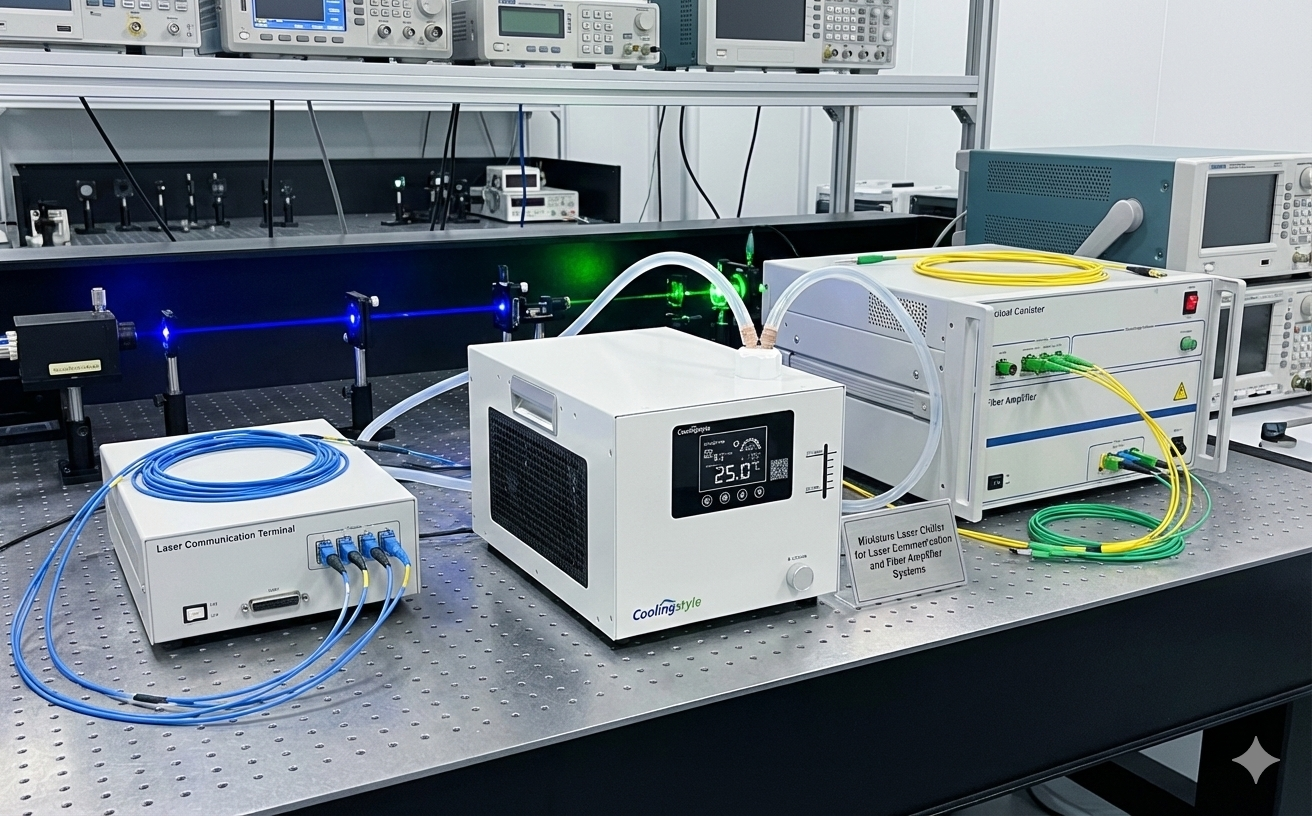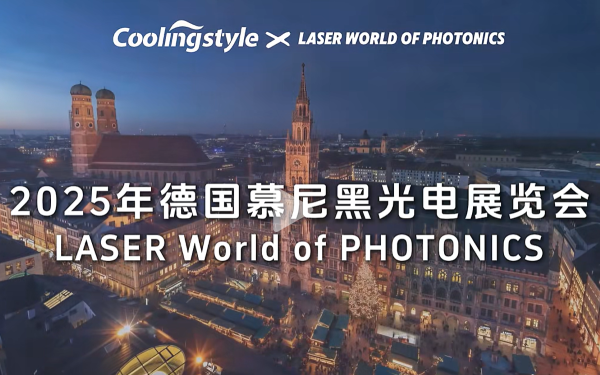الملخص
يعد استقرار درجة الحرارة أمرًا بالغ الأهمية لأداء الأشعة فوق البنفسجية ذات الحالة الصلبة (الأشعة فوق البنفسجية) ماذا نفعل, التأثير على خصائص الإنتاج وكفاءته. تعرض هذه الورقة نظامًا مبتكرًا للتحكم في درجة الحرارة يستخدم نظام تبريد عاكس من النوع DC من نوع ضغط البخار مقترنًا بالتعويض الحراري الكهروحراري. يستفيد النظام من المشتق التناسبي التكاملي (معرف المنتج) التحكم لضبط السرعة والطاقة الكهربائية للضاغط العاكس الصغير DC, تمكين تنظيم درجة الحرارة دقيقة وفعالة. تظهر النتائج التجريبية أن النظام يحقق الاستقرار السريع (6 الدقائق) ودقة عالية (±0.01 درجة مئوية), مما يجعله حلاً فعالاً من حيث التكلفة وصغير الحجم للتطبيقات المتزايدة لأشعة الليزر فوق البنفسجية في وضع العلامات, قطع الدقة, وغيرها من الصناعات.
1. تطور أشعة الليزر فوق البنفسجية ذات الحالة الصلبة
أشعة الليزر فوق البنفسجية, بأطوال موجية ≥400 نانومتر, لا غنى عنها في صناعات مثل المراقبة البيئية, دواء, والتصنيع الدقيق بسبب طول موجتها القصير, دقة عالية, والطاقة المركزة. تطوير أشعة الليزر ذات الحالة الصلبة للأشعة فوق البنفسجية, التي تستخدم الثنائيات الليزر (LDs) كمضخات, لقد أحدث ثورة في هذا المجال من خلال التغلب على قيود ليزر الغاز والإكسيمر, مثل الحجم الكبير, انخفاض الكفاءة, وتكلفة عالية. لقد عززت الابتكارات في التسعينيات والتطورات اللاحقة أهمية أشعة الليزر ذات الحالة الصلبة للأشعة فوق البنفسجية لتطبيقات متنوعة, بما في ذلك معالجة المواد الدقيقة والعلاجات الطبية.
2. التحديات في التحكم في درجة حرارة أجهزة الليزر فوق البنفسجية ذات الحالة الصلبة
إن أداء أشعة الليزر فوق البنفسجية ذات الحالة الصلبة حساس للغاية للتغيرات في درجات الحرارة, مما يؤثر على استقرار LD وكفاءة الكريستال الضوئية غير الخطية. يجب أن يتم تبديد الحرارة المتولدة أثناء ضخ LD وتحويل التردد بشكل فعال لمنع تغيرات معامل الانكسار وانحراف الطول الموجي, مما يؤدي إلى تدهور مخرجات الليزر. طرق التبريد التقليدية مثل الأنظمة المعتمدة على المروحة أو التبريد الحراري (المجلس التنفيذي الانتقالي) مواجهة القيود في الكفاءة, استقرار, وقابلية التوسع. ويكمن الحل الأكثر فعالية في أنظمة التبريد المائي المتقدمة التي تستخدم ضواغط DC صغيرة.
3. مبادئ نظام التحكم في درجة الحرارة

نظرة عامة على النظام:
يدمج النظام المقترح حلقة تبريد بالماء ودورة تبريد بضغط البخار. تشمل المكونات الرئيسية:
- مبادل حراري: يسهل نقل الحرارة بين الماء والمبرد.
- ضاغط: ضاغط عاكس مصغر يعمل بالتيار المستمر (CS-MCQ-19241100) يضبط قدرة التبريد ديناميكيًا.
- سخان كهربائي: يوفر الضبط الدقيق ويعوض عن تجاوز التبريد.
- مستشعر درجة الحرارة: يضمن مستشعر Pt100 مراقبة درجة الحرارة بدقة عالية.
عملية:
يمتص الماء حرارة الليزر ويدور عبر المبادل الحراري, حيث يقوم المبرد بتبريده. يقوم التحكم PID بضبط سرعة الضاغط وقوة السخان لتثبيت درجة حرارة الماء, ضمان تشغيل الليزر متسقة.
4. أجهزة النظام ووظائفه
4.1 نظام التبريد


الضاغط العاكس DC المدمج (56 قطر مم, 850 وزن ز) يحقق سرعات متغيرة لتعديل قدرة التبريد. منحنى أدائها (شكل 3) يسلط الضوء على قدرتها على التكيف, مما يجعلها مثالية للتحكم الدقيق في درجة الحرارة.
4.2 وحدة التدفئة
يعوض السخان الكهربائي تقلبات درجات الحرارة ويمنع التبريد الزائد أثناء ظروف الحمل المنخفض. باستخدام التحكم PWM, يوفر السخان تعديلات دقيقة على الطاقة.
4.3 استشعار درجة الحرارة
يضمن مستشعر Pt100 المزود بتكوين ثلاثي الأسلاك قراءات دقيقة لدرجة الحرارة عن طريق التخلص من تأثيرات مقاومة الأسلاك. بيانات المستشعر, تتم معالجتها من خلال محول A/D, يبلغ خوارزمية التحكم PID.
4.4 التحكم في PID
تقوم خوارزمية PID بضبط سرعة الضاغط وطاقة السخان ديناميكيًا بناءً على أخطاء درجة الحرارة في الوقت الفعلي. تقلل هذه العملية التكرارية من وقت التثبيت وتحافظ على دقة تبلغ ±0.01 درجة مئوية.

5. التحقق التجريبي
إعداد الاختبار:
تم استخدام ليزر UV بقوة 10 وات وحلقة تبريد بالماء سعة 1 لتر. تم ضبط درجة الحرارة المستهدفة على 25 درجة مئوية. شكل 6 يظهر عملية تثبيت درجة الحرارة.
نتائج:
- وقت الاستقرار: 6 الدقائق.
- دقة درجة الحرارة: ±0.01 درجة مئوية.
يحافظ النظام بشكل فعال على درجة حرارة تشغيل الليزر, مما يؤكد دقتها العالية واستجابتها.

6. المزايا النسبية
مقارنة بطرق التبريد التقليدية:
- حجم صغير & خفيفة الوزن: مثالية للتطبيقات ذات المساحة المحدودة.
- كفاءة الطاقة: قدرة تبريد فائقة واستهلاك أقل للطاقة.
- فعالية التكلفة: قادرة على المنافسة مع أنظمة TEC مع تقديم دقة أعلى.
- براعة: التوافق مع معايير إمدادات الطاقة المختلفة.

7. خاتمة
تقدم هذه الدراسة نظامًا عالي الدقة للتحكم في درجة الحرارة لجميع أجهزة الليزر ذات الحالة الصلبة للأشعة فوق البنفسجية, الاستفادة من ضاغط DC المصغر والتعويض الحراري الكهربائي. التصميم المدمج للنظام, الاستقرار السريع, ودقة استثنائية (±0.01 درجة مئوية) جعله حلاً عمليًا للتطبيقات الصناعية مثل وضع العلامات والقطع الدقيق. إن قابلية التوسع وكفاءتها تحمل وعدًا كبيرًا لتطوير تقنيات التبريد بالليزر وتعزيز اعتمادها على نطاق واسع.
فهرس
[1] ميمان تي إتش. تحفيز الإشعاع الضوئي في الياقوت [ي]. طبيعة سجية, 1960, 187.
[2] فو, زهونغ. تطبيق وتطوير الليزر [ي]. التكنولوجيا الالكترونية وهندسة البرمجيات, 2017(5).
[3] شين Zhaoguo. البحث عن الليزر الأخضر 532 نانومتر و 355 نانومتر فوق البنفسجي [د]. جامعة نورث وسترن, 2009.
[4] طيب صباحا, ليو إل واي. كل حالة صلبة مستمرة تردد الموجة أربعة أضعاف Nd: ليزر ياج [ي]. مجلة IEEE لموضوعات مختارة في الإلكترونيات الكمومية, 1995, 1(3):ص 859-866.
[5] ن. هودجسون, د. دودلي, إل. جروبر, وآخرون. نهاية الصمام الثنائي ضخ, TEM / فرعي 00/ اختصار الثاني: YVO / الفرعية 4/ الليزر مع انتاج الطاقة أكبر من 12 W في 355 نانومتر[ج]// مؤتمر عن الليزر & البصريات الكهربائية. IEEE, 2001.
[6] ديفيد ر. دودلي, أوليفر ميهل, غاري واي. وانغ, وآخرون. Nd- ضخ الصمام الثنائي بتبديل Q: ليزر YAG على شكل قضيب بقوة إخراج تبلغ 420 واط عند 532 نانومتر و 160 واط عند 355 نانومتر [ي]. وقائع Spie الجمعية الدولية للهندسة البصرية, 2009, 7193(1):28.
[7] تشن ج., وانغ X.H., دو جوجو. البحث عن جميع أنواع الليزر ذات الحالة الصلبة فوق البنفسجية [ي]. مجلة الضوئيات, 1999(09):785-788.
[8] شاولين وانغ, كايفا كاو, تسونغ مينغ تاو, وآخرون. بحث حول النظام الطيفي لبخار الماء فوق البنفسجي رامان ليدار [ي]. مجلة الإلكترونيات الضوئية - الليزر, 2010, 21 (08):1171-1175.
[9] شيويه تشون تان. جهاز محاكاة الرادار بالليزر والبحوث التجريبية [د]. جامعة تشانغتشون للعلوم والتكنولوجيا, 2012
[10] ماكجيل ماثيو, هلافكا دينيس, هارت وليام, وآخرون. الفيزياء السحابية ليدار: وصف الأداة ونتائج القياس الأولية. 2002, 41(18):3725-34.
[11] يانغ وانغ |, شو باو وانغ, زان لينغ دونغ, وآخرون. التعبير عن β-Catenin و Peroxisome Proliferator-Activated Receptor البروتين في أنسجة الكبد المشعة بواسطة الليزر فوق البنفسجي[ي]. المجلة الصينية لأبحاث هندسة الأنسجة, 2011,15(33):6191-6195.
[12] يوليو عليه, كيني كيو. تطبيق الاتصالات فوق البنفسجية في نظام الاتصالات العسكرية. بصريات & تكنولوجيا الإلكترونيات الضوئية[ي],2005( 04):19-21.
[13] ليس S.. ل., Guan Y. ج. الليزر فوق البنفسجي وتطبيقاته في الآلات الدقيقة [ي]. الهندسة الكهروضوئية, 2017, 44(12):1169-1179+1251.
[14] وانغ د. استكشاف توليد وتطبيقات ليزر الفيمتو فوق البنفسجي العميق والفراغ [د]. جامعة شرق الصين العادية, 2016.
[15] تي جي كيم, إم أوغورا. درجة حرارة مميزة عالية (T o = 322 K بالقرب من درجة حرارة الغرفة) من ليزر الدايود السلكي الكمومي Al GaAs-GaAs[ي]. إلكترونيات الحالة الصلبة, 2000, 44(1).
[16] اقرأ L, لينغ هو, سفينة, تيان ف, باي جيه تي. بحث في مجال درجة حرارة الكريستال KTP غير الخطي في نظام الليزر المبرد بالماء[ي]. الليزر & الأشعة تحت الحمراء, 2005(01):51-54.
[17] تسنغ إتش إل, جيانغ ف, شيه اف تسنغ. بحث في التحكم في درجة حرارة ليزر أشباه الموصلات [ي]. الليزر والأشعة تحت الحمراء, 2004(05):339-340+346.






1 فكر في "التحكم الدقيق في درجة الحرارة لجميع أجهزة الليزر فوق البنفسجية ذات الحالة الصلبة باستخدام أنظمة ضاغط DC المصغرة: نهج جديد”
هذه هي المرة الأولى التي أقوم فيها بزيارة هنا وأنا سعيد حقًا بقراءة كل شيء في مكان واحد.